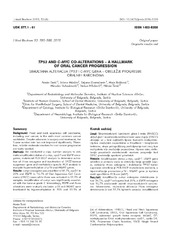Приказ основних података о документу
Simultana alteracija TP53 i c-myc gena - obeležje progresije oralnih karcinoma
TP53 and c-myc Co-alterations: A hallmark of oral cancer progression
| dc.creator | Tanić, Nasta | |
| dc.creator | Milašin, Jelena | |
| dc.creator | Dramićanin, Tatjana | |
| dc.creator | Bošković, Maja | |
| dc.creator | Vukadinović, Miroslav | |
| dc.creator | Milošević, Verica | |
| dc.creator | Tanić, Nikola | |
| dc.date.accessioned | 2015-08-28T10:26:51Z | |
| dc.date.available | 2015-08-28T10:26:51Z | |
| dc.date.issued | 2013 | |
| dc.date.issued | 2013 | sr |
| dc.identifier.issn | 1452-8258 | sr |
| dc.identifier.other | Rad_konverzija_544 | sr |
| dc.identifier.uri | https://radar.ibiss.bg.ac.rs/handle/123456789/505 | |
| dc.description.abstract | Background: Head and neck squamous cell carcinoma, including oral cancer, is the sixth most common cancer worldwide. Despite advances in surgery and treatment, the 5-year survival rate has not improved significantly. Therefore, reliable molecular markers for oral cancer progression are badly needed. Methods: We conducted a copy number analysis to estimate amplification status of c-myc, cycD1 and EGFR oncogenes, mutational PCR-SSCP analysis to determine activation of H-ras oncogene and inactivation of TP53 tumour suppressor gene and methylation specific PCR analysis to evaluate hypermethylation of p16 and MGMT genes. Results: c-myc oncogene was amplified in 56.7%, cycDI in 20% and EGFR in 16.7% of Oral Squamous Cell Carcinoma (OSCC) cases while H-ras was activated in 33.3% of samples. Amplification of c-myc was significantly associated with the tumour grade 2. Interestingly, EGFR and H-ras alterations were mutually exclusive. p16 and MGMT were inactivated by hypermethylation in 30% and 13.3% of cases. Co-alteration of cycDI and p16 were not observed in any of the analyzed samples. TP53 was inactivated in 56.7% of samples and was significantly associated with progression of OSCC, grade 2 and stage 2. Moreover, TP53 and c-myc oncogene were simultaneously altered in grade 2 OSCC. Conclusions: The most promising marker of OSCC progression remains the TP53 tumour suppressor, which is the most frequently mutated gene in oral cancers. Since there is synergism between TP53 and c-myc, it seems that co-alteration of these two genes could be also a good marker of OSCC progression from grade1 to grade 2 tumours. | en |
| dc.description.abstract | Uvod: Skvamocelularni karcinomi glave i vrata (HNSCC) uključujući i skvamocelularni karcinom usne duplje (OSCC) ubrajaju se u šest najčešćih tipova humanih maligniteta. Uprkos značajnim napredcima u hirurškom i terapijskom tretmanu, stopa petogodišnjeg preživljavanja kod ovog tipa maligniteta nije značajnije popravljena. Upravo zato, definisanje pouzdanih molekularnih markera progresije kod OSSC predstavlja apsolutni prioritetet. Metode: Amplifikacioni status c-myc, cycD1 i EGFR gena određen je pomoću eseja za detekciju broja genskih kopija, aktivacija H-ras onkogena i inaktivacija TP53 tumor supresora određena je PCR-SSCP mutacionom analizom, a hipermetilacija promotora p16 i MGMT gena je ispitana metil specifičnim PCR-om (MSP). Rezultati: Amplifikacija c-myc onkogena detektovana je kod 56,7%, cycD1 onkogena kod 20%, a EGFR onkogena kod 16,7% analiziranih oralnih skvamocelularnih carcinoma. Istovremeno, mutaciona aktivacija H-ras onkogena detektovana je kod 33,3% ispitanih uzoraka. Amplifikovani c-myc, statistički značajno korelira sa gradusom 2 OSCC. Posebno intrigantan je bio nalaz po kom se onkogene aktivacije u EGFR i H-ras genu međusobno isključuju. Hipermetilacija promotora p16 gena detektovana je kod 30%, a MGMT kod 13,3% analiziranih uzoraka. Ko-alteracije cycDI i p16 gena nisu zapažene ni u jednom od analiziranih uzoraka. Inaktivacija TP53 gena detektovana je kod 56,7% uzoraka i utvrđeno je da statistički značajno korelira sa gradusom 2 i statusom 2 OSCC. Pored ovoga, utvrđeno je da statistički značajan broj uzoraka gradusa 2, sa aktiviranim TP53 genom ima istovremeno aktiviran i c-myc onkogen. Zaključak: TP53, najčešće mutirani gen u oralnim karcinomima, ostaje za sada i najpouzdaniji marker progresije kod OSCC. Obzirom na detektovani sinergizam između TP53 i c-myc gena, možemo reći da su istovremene promene u ova dva gena još pouzdaniji pokazatelj progresije OSSC iz gradusa 1 u gradus 2. | sr |
| dc.description.sponsorship | Projekat ministarstva br. III 41031 i br. ON173049 | sr |
| dc.language.iso | eng | sr |
| dc.rights | openAccess | sr |
| dc.source | Journal of Medical Biochemistry | sr |
| dc.subject | c-myc | ENG |
| dc.subject | c-myc | SRP |
| dc.subject | oncogenes | ENG |
| dc.subject | onkogeni | SRP |
| dc.subject | oral squamous cell carcinoma | ENG |
| dc.subject | progresija tumora | SRP |
| dc.subject | TP53 | SRP |
| dc.subject | TP53 | ENG |
| dc.subject | tumour progression | ENG |
| dc.subject | tumor supresori | SRP |
| dc.subject | skvamocelularni karcinom usne duplje | SRP |
| dc.subject | tumour suppressors | ENG |
| dc.title | Simultana alteracija TP53 i c-myc gena - obeležje progresije oralnih karcinoma | sr |
| dc.title | TP53 and c-myc Co-alterations: A hallmark of oral cancer progression | en |
| dc.type | article | sr |
| dc.rights.license | ARR | |
| dcterms.abstract | Танић, Никола; Танић, Наста; Драмићанин, Татјана; Бошковић, Маја; Вукадиновић, Мирослав; Милошевић, Верица; Милашин, Јелена; | |
| dc.citation.issue | 4 | sr |
| dc.citation.volume | 32 | sr |
| dc.citation.spage | 380 | sr |
| dc.citation.epage | 388 | sr |
| dc.type.version | publishedVersion | sr |
| dc.identifier.fulltext | https://radar.ibiss.bg.ac.rs//bitstream/id/2890/Rad_konverzija_544.pdf | |
| dc.citation.rank | M23 | |
| dc.identifier.rcub | https://hdl.handle.net/21.15107/rcub_ibiss_505 |

